
Sir Robert Smirke was an English architect, one of the leaders of Greek Revival architecture, though he also used other architectural styles. As architect to the Board of Works, he designed several major public buildings, including the main block and façade of the British Museum. He was a pioneer of the use of concrete foundations.

St Mary's Church, Bramall Lane is a Church of England parish church in the City of Sheffield, England.
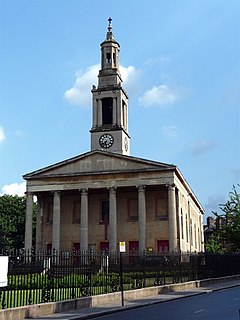
St Luke's Church in West Norwood is an Anglican church that worships in a Grade II* listed building. It stands on a prominent triangular site at the south end of Norwood Road, where the highway forks to become Knights Hill and Norwood High Street.

St Thomas' Church is in St Thomas's Place, Wellington Road South, Stockport, Greater Manchester, England. It is an active Church of England church in the parish of Stockport and Brinnington, in the deanery of Stockport, the archdeaconry of Macclesfield, and the diocese of Chester. The church is recorded in the National Heritage List for England as a designated Grade I listed building. It was a Commissioners' church, having received a grant towards its construction from the Church Building Commission.

A Commissioners' church, also known as a Waterloo church and Million Act church, is an Anglican church in the United Kingdom built with money voted by Parliament as a result of the Church Building Acts of 1818 and 1824. The 1818 Act supplied a grant of money and established the Church Building Commission to direct its use, and in 1824 made a further grant of money. In addition to paying for the building of churches, the Commission had powers to divide and subdivide parishes, and to provide endowments. The Commission continued to function as a separate body until the end of 1856, when it was absorbed into the Ecclesiastical Commission. In some cases the Commissioners provided the full cost of the new church; in other cases they provided a partial grant and the balance was raised locally. In total 612 new churches were provided, mainly in expanding industrial towns and cities.
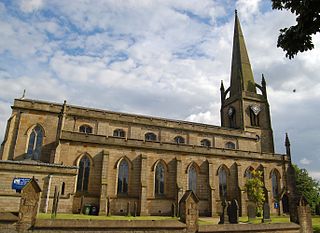
St George's Church is an Anglican parish church serving Tyldesley and Shakerley in Greater Manchester, England. It is part of Leigh deanery in the archdeaconry of Salford and the diocese of Manchester. The church, together with St Stephen's Church, Astley and St John's Church, Mosley Common is part of the united benefice of Astley, Tyldesley and Mosley Common.
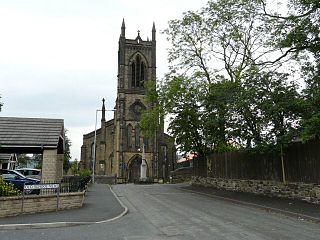
St John's Church is in Oxford Road, Dukinfield, Greater Manchester, England. It is an active Anglican parish church in the deanery of Mottram, the archdeaconry of Macclesfield and the diocese of Chester. The church is recorded in the National Heritage List for England as a designated Grade II listed building. It stands in an elevated position at the top of a small hill.

Old St Stephen's Church is a redundant Anglican church standing on a hillside in Fylingdales, overlooking Robin Hood's Bay, North Yorkshire, England. It is recorded in the National Heritage List for England as a designated Grade I listed building, and is under the care of the Churches Conservation Trust.

St James, Norton is the Church of England parish church of the Norton district of Sheffield, South Yorkshire, England.
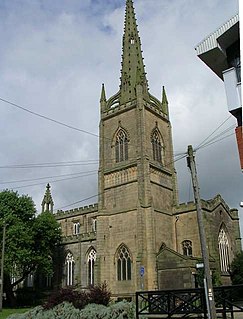
St Peter's Church is a redundant Anglican parish church in St Peter's Square, Preston, Lancashire, England. It is recorded in the National Heritage List for England as a designated Grade II* listed building. It was a Commissioners' church, having received a grant towards its construction from the Church Building Commission. In 1973 it became part of Preston Polytechnic, later the University of Central Lancashire.

St George's Church is in St George's Street, Chorley, Lancashire, England. It is an active Anglican parish church in the deanery of Chorley, the archdeaconry of Blackburn, and the diocese of Blackburn. The church is recorded in the National Heritage List for England as a designated Grade II* listed building. It was a Commissioners' church, having received a grant towards its construction from the Church Building Commission.

St John the Baptist's Church is a redundant Anglican parish church in Church Street, Bollington, Cheshire, England. It is recorded in the National Heritage List for England as a designated Grade II listed building. It was a Commissioners' church, having received a grant towards its construction from the Church Building Commission. The parish church is now St Oswald's Church, Bollington.

St John the Baptist Church is in Liverpool Road North, Burscough, Lancashire, England. It is an active Anglican parish church in the deanery of Ormskirk, the archdeaconry of Warrington, and the diocese of Liverpool. Its benefice has been united with those of St Andrew, Burscough Bridge, St Cyprian, Burscough Bridge, and Oaks, Burscough Bridge. The church is recorded in the National Heritage List for England as a designated Grade II* listed building. It was a Commissioners' church, having received a grant towards its construction from the Church Building Commission.
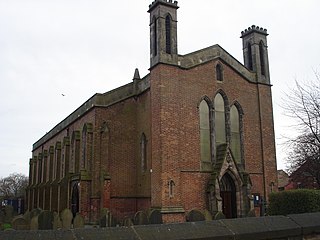
St John the Divine's Church is in Church Street, Lamberhead Green, Pemberton, Wigan, Greater Manchester, England. It is an active Anglican parish church in the deanery of Wigan, the archdeaconry of Warrington, and the diocese of Liverpool. The church is recorded in the National Heritage List for England as a designated Grade II listed building. It was a Commissioners' church, having received a grant towards its construction from the Church Building Commission.
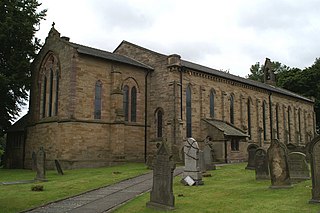
St David's Church is in Copperas Lane, Haigh, Wigan, Greater Manchester, England. It is an active Anglican parish church in the deanery of Wigan, the archdeaconry of Warrington, and the diocese of Liverpool. The church is recorded in the National Heritage List for England as a designated Grade II listed building. It was a Commissioners' church, having received a grant towards its construction from the Church Building Commission.

The Parish Church of St Luke, Chelsea, is an Anglican church, on Sydney Street, Chelsea, London SW3, just off the King's Road. Ecclesiastically it is in the Deanery of Chelsea, part of the Diocese of London. It was designed by James Savage in 1819 and is of architectural significance as one of the earliest Gothic Revival churches in London, perhaps the earliest to be a complete new construction. St Luke's is one of the first group of Commissioners' churches, having received a grant of £8,333 towards its construction with money voted by Parliament as a result of the Church Building Act of 1818. The church is recorded in the National Heritage List for England as a designated Grade I listed building. The gardens of St Luke's are Grade II listed on the Register of Historic Parks and Gardens.

William Swinden Barber FRIBA, also W. S. Barber or W. Swinden Barber, was an English Gothic Revival and Arts and Crafts architect, specialising in modest but finely furnished Anglican churches. The Barber churches often had crenellated bell-towers. He was based in Brighouse and Halifax in the West Riding of Yorkshire. At least 15 surviving examples of his work are Grade II listed buildings including his 1875 design for the Victoria Cross at Akroydon. An 1864 portrait by David Wilkie Wynfield depicts him in Romantic garb, holding a flower. He served in the Artists Rifles regiment in the 1860s alongside Wynfield and other contemporary artists.
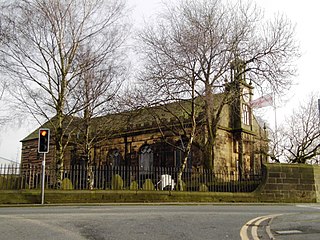
St Aidan's Church is in Main Street, Billinge, St Helens, Merseyside, England. It is an active Anglican parish church in the diocese of Liverpool. It was built in 1716–18 to replace a chapel of ease on the site, and was remodelled and extended in 1907–08. The church is recorded in the National Heritage List for England as a designated Grade II* listed building.

The Church of St John the Divine is in Burnley Road, Holme Chapel, a village in the civil parish of Cliviger, near Burnley, Lancashire, England. It is an active Anglican parish church in the diocese of Blackburn, and the church is recorded in the National Heritage List for England as a designated Grade II listed building. It was built between 1788 and 1794, replacing a small chapel, and is in simple Classical style. Above the west front is a bell turret with an octagonal cupola, and inside the church are carved oak stalls, moved from a demolished church, which include a poppyhead and misericords.

St Thomas is a former Anglican church in the Brightside area of Sheffield in England which now serves as a circus training school.























